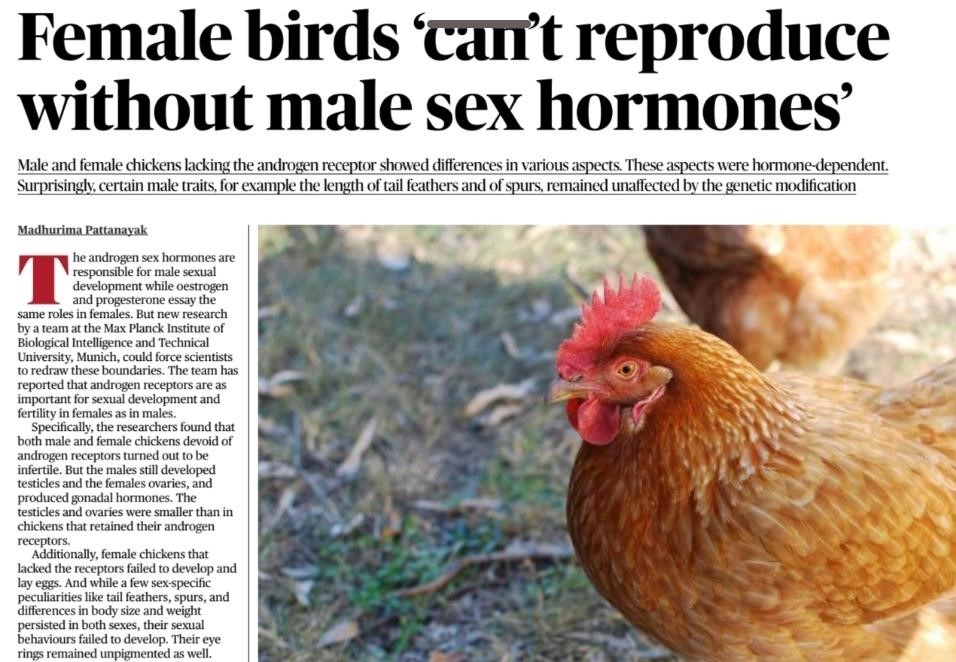Androgen Receptors: Key to Avian Sexuality
Syllabus:
GS 3:
- Science and technology
- Development of Science and technology and their application in everyday life.
Why in the News?
A recent study by researchers at the Max Planck Institute of Biological Intelligence and Technical University, Munich, highlights the critical role of androgen receptors in sexual development and fertility in both male and female birds. This challenges previous beliefs about the role of hormones like testosterone, oestrogen, and progesterone, traditionally associated with specific sexes.
Key Findings on Sexual Development
- Androgen receptor dependency: Both male and female chickens without androgen receptors were infertile, though their testicles and ovaries were smaller in size compared to normal chickens.
- Failure to lay eggs: Female chickens lacking the receptors could not develop and lay eggs, demonstrating the role of androgen signalling in ovarian development and function.
- Hormonal peculiarities: While sex-specific traits like tail feathers and spurs remained unaffected by the absence of androgen receptors, sexual behaviors and pigmentation of eye rings failed to develop.
- Delayed bursal involution: The bursa of Fabricius, a lymphoid organ responsible for antibody production, failed to shrink in androgen-receptor-deficient chickens, indicating its role in sexual growth and maturation.
- Comb development: The absence of androgen receptors prevented comb growth, even after exposure to testosterone, underscoring the necessity of receptor-mediated androgen activity.
Understanding Androgen Receptors (AR):
The androgen receptor (AR) is a protein that binds to male hormones called androgens and regulates the activity of specific genes:
- Function
- ARs are found in many tissues, including male reproductive tissue, and some cancer cells. They help regulate male sexual development and maturation, spermatogenesis, hair growth, and sex drive.
- Structure
- ARs are part of the steroid hormone receptor family, which also includes the estrogen receptor, glucocorticoid receptor, progesterone receptor, and mineralocorticoid receptor.
- Location
- ARs are concentrated in the shoulders, upper and middle chest, and neck.
- Role in prostate cancer
- ARs are critical in the promotion of prostate cancer, and variations in the AR gene may increase the risk of developing prostate cancer. AR-V7 is a splice variant of the AR that can be detected in metastatic prostate cancer patients.
- Drugs
- Drugs such as abiraterone and enzalutamide target ARs to improve survival of prostate cancer patients. However, patients can develop resistance to these drugs.
Insights into Hormonal Action
- Dual role of testosterone: Testosterone functions via androgen receptors and is converted to oestrogen in the brain, highlighting its complex influence on sexual development and behavior.
- Sexual dimorphism: Androgen signalling impacts sex-specific characteristics, such as head ornaments and gonadal development, in both sexes.
- Receptor-specific action: Androgen and oestrogen receptors mediate the effects of corresponding hormones, with their absence disrupting the hormone’s role in sexual maturation.
- Circadian rhythm in crowing: Male chickens without androgen receptors failed to crow, indicating that neural circuits governing this behavior depend on androgen signalling.
- Commercial implications: Male chickens are castrated in commercial settings to reduce androgen levels and increase body weight, showcasing the practical applications of hormonal knowledge.
Challenges in Understanding Avian Sexual Development
- Hormone independence: Certain sexual traits like tail feathers and spurs in male chickens were unaffected, suggesting the involvement of hormone-independent mechanisms.
- Complex interactions: The interplay between androgen and oestrogen signalling complicates the understanding of their roles in sexual development, particularly in birds.
- Genetic manipulation limitations: Despite advancements like CRISPR/Cas9, fully decoding the mechanisms behind sexual dimorphism remains challenging due to the interplay of genetics and environment.
- Behavioral development: The failure of sexual behaviors to develop in androgen-receptor-deficient chickens reveals the intricacies of hormone-driven neural and behavioral processes.
- Comparative studies: Contrasting findings in mammals and birds highlight the need for species-specific studies to understand sexual differentiation mechanisms
Way Forward
- Expanded research: Conduct comparative studies on androgen and oestrogen signalling across avian and mammalian species to better understand their roles in sexual development.
- Focus on non-hormonal traits: Investigate the genetic and environmental factors influencing hormone-independent traits, such as tail feathers and spurs.
- Refinement of genetic tools: Enhance gene-editing techniques to study the intricate mechanisms governing sexual dimorphism and fertility in birds.
- Hormone therapy applications: Explore the potential of hormone receptor modulation for addressing fertility and developmental issues in poultry farming.
- Integrative approach: Adopt multidisciplinary strategies combining genetics, endocrinology, and behavior studies to decode the complexities of avian sexual development.
Conclusion
The study underscores the essential role of androgen receptors in avian sexual development, challenging traditional distinctions between male and female hormones. This revelation highlights the intricate and interconnected nature of hormone-dependent and hormone-independent mechanisms, paving the way for further research into the biological complexities of sexual differentiation.
Source: The Hindu
Mains Practice Question
Examine the significance of androgen receptors in avian sexual development. Discuss how recent findings challenge traditional views of hormonal action and suggest pathways for further research in the field.




